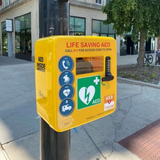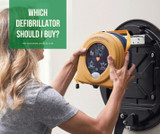What is the success rate of a defibrillator?
A sudden cardiac arrest occurs when there is an electrical fault with the heart. It either stops beating or, begins to beat either too fast or slow. When this happens, the victim will fall unconscious and stop breathing. Unfortunately, their chances of survival are slim so, it is important to call the emergency services straight away and then begin CPR and use a defibrillator.
Defibrillators work by shocking the heart in order for it to start beating again at it’s natural pace after someone has suffered a sudden cardiac arrest. Once electrodes are placed on the chest, it scans the heart’s rhythm to determine whether a shock is needed. If a shock is required, the defibrillator will either deliver the shock for you or, will alert you to press a button to deliver the shock. This is dependent on whether you have an automatic or semi-automatic defibrillator.
All defibrillators are designed with ease of use in mind. This means that the instructions are easy to follow with most defibrillators having audio and visual guides to show you through the process. Whether you are a medical professional or, have never used a defibrillator before, their easy to use design means you can still deliver life saving care.
Sudden cardiac arrests can happen to anyone at anytime. This means that people regardless of age, gender or ethnicity can suffer from a cardiac arrest. Naturally, if someone suffers a sudden cardiac arrest whilst they are in hospital, their chances of survival are as high as they can. This is because they are in an environment with medical professionals and close to life saving equipment. This of course, isn’t always the case though. Tens of thousands of people every year suffer from sudden cardiac arrests outside of hospital and when this happens, the chance of someone surviving decreases.
If someone suffers an out of hospital cardiac arrest, their survival rate is less than 10%. With the quick use of a defibrillator however, this survival rate increases to an impressive 80%. As more minutes pass, the success rate of a defibrillator decreases. Deploying a defibrillator within three to five minutes of collapse means survival rates are between 50% and 70%.
Without a defibrillator however, survival rates are very slim. Before defibrillators were introduced in public areas and hospitals, people had to rely on CPR alone. An impressive success rate when used straight away means that thousands more lives can be saved every year. The British Heart Foundation and other heart research charities are advocating for many more defibrillators to be installed across the country.
There are currently 10,000 defibrillators installed in public areas across the UK in places such as supermarkets, sports facilities, local towns and villages, gyms, offices and schools. You can view a map online to see where all defibrillators are located. It is worth noting where your nearest defibrillator is. With defibrillators really making the difference between life and death, the more that are installed across the country, the safer everyone can be.
Recent Posts
-
Empowering Communities: The Lifesaving Impact of CPR on Restart a Heart Day
Every year, on and around October 16th, an important event takes place - Restart a Heart Day. This a …16th Oct 2023 -
Which home defibrillator?
80% of all out of hospital cardiac arrests occur at home. Defibrillators are often available in loca …4th Dec 2022 -
Which defibrillator should I buy?
There are many defibrillators available on the market and it can become overwhelming knowing which o …4th Nov 2022




